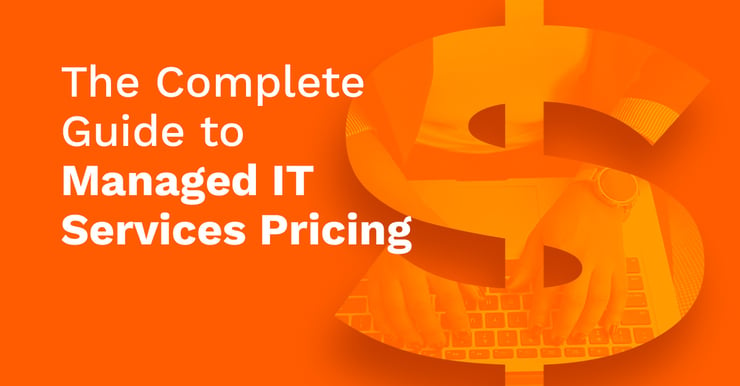There’s more to managed IT services than just finding the right provider. Pricing also plays an outsized role in an organization’s decision-making process, whether it’s to find an ideal provider or even offer managed IT services of their own.

For companies interested in the advantages that managed IT services have to offer, determining a fair and profitable pricing strategy can prove incredibly challenging. The opaque nature of MSP pricing makes it difficult to chart a profitable approach, especially as most providers fear giving their competitors an unintended edge by divulging their pricing structure.
Fortunately, this comprehensive guide is designed to take the mystery out of managed IT services pricing. By shining a spotlight on common pricing strategies and practices, this guide will help you create a profitable roadmap for choosing the best managed IT services provider.

What is Managed IT Services?
Before diving into the pricing structures commonly employed by managed IT services providers, let’s take a moment to explore the concept of managed IT services. After all, it’s a term that’s constantly used throughout the industry, but without much focus on its deeper meaning.
At its core, managed IT services is a term that encompasses a broad array of IT management services handled by third-party vendors, as opposed to in-house IT staff. In short, these vendors effectively “manage” various aspects of an organization’s IT environment. Such aspects run the gamut from on-site support and remote support to troubleshooting, remote monitoring, cybersecurity, and data recovery.
These aspects are usually defined in the service level agreement or SLA between the client and managed service provider, along with expectations regarding uptime, response time, data monitoring, and support, among other items.
Managed IT services are typically divided into comprehensive or fully managed IT services and partial managed IT services. With the former, the managed IT team typically assumes responsibility for all aspects of an organization’s IT needs, from help desk support to collaborative efforts with C-suite leadership. The latter typically limits the scope of a provider’s responsibilities to specific areas of IT management, such as cybersecurity or backup administration.
Managed Service Provider vs. Managed IT Services Provider
At first glance, it may seem like there is little distinction between the terms “managed service provider” and “managed IT services provider.” Even the experts use these terms interchangeably throughout the industry. However, there is a notable distinction between these terms that’s worth mentioning.
Think of “managed services provider” as a catch-all term describing organizations that provide outsourced support for specific business functions on an ongoing basis. A “managed IT services provider” does the same, but the term puts greater focus on maintaining IT infrastructure as opposed to offering general managed services.
Factors to Consider and Cost Impacts
What you’ll expect to pay for managed IT services will depend on a broad range of factors. After all, MSPs must factor how much time and resources it’ll need to effectively assist their clients. Harder jobs that demand more of both will inevitably demand a higher spend. An MSP’s pricing model must also account for unpredictable jobs that suddenly demand more time and resources than expected.
If you want to know how much an MSP will likely charge your company for their services, you’ll want to keep the following factors in mind:
Individual vs. Comprehensive Services
When an MSP tasked with monitoring your IT environment spots an issue, that same MSP can be tasked with addressing the issue. That usually means bringing an IT professional on board to examine the issue and identify and implement a solution. With only so many employees available, however, an MSP may be forced to pull a team member from an existing project temporarily.
When you pay for individual services, you’re usually paying for an IT professional to meet your needs on a per case basis. While that seems cost-effective at first, having your MSP pull someone from an existing job for each incident can increase costs in the long run.
Contrast that to comprehensive services, which usually gives you a dedicated IT expert on hand to handle any issues that pop up. Although such services cost more and the MSP may need to shift resources around to cover unexpected requests, you’ll have team members more devoted to managing your IT infrastructure.
Remote vs. On-Site Services
You should also consider whether your organization needs someone on-site on at least a part-time basis or if it can subsist with remote services. While the latter offers a low initial price point, you may be more comfortable with an on-site presence for situations requiring a more hands-on solution. However, on-site services tend to come with a potentially higher cost.
Your Organization’s IT Environment
Laptops, desktops, tablets and smartphones aren’t the only elements of your IT environment worth considering. You also have servers, Wi-Fi appliances for guests and internal use, workstations and numerous other network-enabled devices. There’s also the software used to interact between and protect those devices, including antivirus software and web filtering applications. It’s not hard to envision the complexity of the typical IT environment, especially as organizations grow and not only adopt new technologies, but also add new devices and end-users.
Unless you’re running a small business or have already had prior help from an IT professional, you might not have a complete picture of your company’s technology matrix. Nevertheless, it’s important to take stock of your IT environment and what aspects of that environment you want your MSP to focus on.
What If You Have Your Own IT Team?
Having your own IT staff in place can add extra variables to your decision-making process. However, that depends on how integrated that staff is with your company and its technological needs. Depending on your organization’s structure, you may have one of the following in place:
- One or more dedicated IT professionals with the training and credentials to handle most IT functions
- One or more employees who don’t specialize in IT, but are capable of handling basic IT tasks
- A combination of the above that varies based on a variety of factors including device count and technology type
It’s up to you to decide whether maintaining your current IT team and integrating that team into your chosen MSP is the best choice for your company. If you have dedicated IT staff on hand, consult with them to see if managed IT services can fill in gaps that exist and/or augment existing capabilities among in-house IT staff. Otherwise, outsourcing IT roles can help redirect employees normally tasked with IT towards areas where their talents are put to better use.
Managed IT Services Pricing Models
Managed IT services pricing depends on a variety of factors, making it difficult to pin down precise numbers. Every business is different and the specific technologies they use on a regular basis can vary significantly in complexity. After all, maintenance costs increase as technology becomes more complex.
Instead of looking for specific numbers that cover every possible IT service scenario, let’s take a quick look at the six most popular managed services pricing models. These models cover a broad range of managed IT services while offering a more accurate pricing scope.
Per Device
The per-device pricing model remains a popular one with managed IT service providers and for good reason. This pricing model allows providers to tally their monthly fee based on the number of devices, including PCs, servers and workstations, owned by the client.
Many MSPs find it easier to calculate their monthly billing based on device count rather than the number of end users. The flat fee also works to the advantage of customers with few users, but multiple devices. MSPs can charge less to support smaller and less-complicated devices, such as work phones and tablets.
However, things can get complicated as the number of supported devices grows. The proliferation of smartphones and tablets, along with recent trends like “bring your own device” (BYOD) and “work from home” (WFH), can create unexpected complications when it comes to billing. In many cases, the per-user model may prove the better approach when faced with dozens or even hundreds of different devices.
A notable downside of this pricing model for MSPs is that it could create unrealistic expectations among clients, especially if they intuit an MSP’s per-unit pricing structure. If a provider offers IT support for a dozen computers at $200 per device and a client removes two of those devices, the client may expect a $400 savings in spite of the provider’s backend costs.
Per User
As you’d expect, the per-user pricing model lets MSPs calculate your monthly fee based on the number of users. In most cases, this model covers support for all devices used by each end-user, leading to fewer billing headaches for MSPs supporting clients with multiple devices. End users are tallied during the onboarding process, with most MSPs conducting annual or semi-annual audits to reconcile user counts and maintain competitive pricing.
Per-user pricing makes it easier to generate quotes quickly since providers aren’t bogged down with pricing for individual devices. The per-user pricing model also prevents cannibalization of monthly recurring revenue by cloud-based services. If a client decides to transition a server to the cloud, the price per user remains unchanged.
All You Can Eat
Unlimited or “all you can eat” managed services contracts were once popular with MSPs, most notably new entrants focused on growth and client acquisition. In essence, this approach encourages clients to sign up by offering a nearly unlimited range of proactive IT services for a guaranteed fixed price. The all you can eat pricing model also eliminates complexity by simplifying the roster of available service packages.
This pricing model appeals to business owners who want all of their bases covered at a reasonable cost, as well as clients transitioning from break/fix pricing models. However, the fixed-price nature of the all you can eat model makes it difficult to adjust pricing structures to maintain profitability.
Break/Fix Pricing
The break/fix approach to managed IT services is just as the name implies. Unlike MSPs that offer proactive managed IT services, a break/fix MSP only provides service when something breaks or needs repair.
Break/fix IT firms may charge hourly or flat rates depending on the type of services needed. Flat rates for troubleshooting and device repair may range from as little as $40 or up to $350 per session. Hourly rates can range anywhere from $75 to $250 per hour, depending on the requested services, transportation costs for site visits, and other factors.
Break/fix pricing can be quite cost-effective for firms that rarely suffer downtime, but frequent service calls can quickly erode those savings. As a result, break/fix firms may not interact with their clients for weeks at a time. MSPs that rely on this pricing model typically supplement those jobs with other revenue streams, such as software licensing or hardware sales.
A La Carte Pricing Model
Unlike other managed IT services that are all-inclusive, the “a la carte” pricing model lets organizations pay only for the services they need. This approach allows you to build the exact suite of services your organization needs most, providing significant cost savings over pre-priced packages.
A la carte models are cost-effective for many companies, but due diligence is necessary when building desired packages.
Tiered Pricing Model
Many MSPs sell their services in the form of bundled packages. These packages usually range from budget-tier services that include basic antivirus and anti-malware security to premium packages offering a complete suite of services, along with 24/7 support.
The tiered pricing approach allows MSPs to tailor their offerings to best suit the market and achieve maximum profitability. Unfortunately, the tiered pricing model lacks the a la carte pricing model’s flexibility, especially for small businesses looking to maximize their tight budgets.
What’s Included in Managed IT Services Prices?
With numerous pricing models to sort through, finding one that adds value to your organization can take significant time and effort. This is especially true for organizations unsure of the features and services included in managed IT services prices.
Knowing what your organization will get for its investment is crucial to understanding the above pricing models. Here’s a close look into what’s included in managed IT services prices:
Monitoring Services
Monitoring services are the cornerstone of any managed IT services offering. You can opt for a service that offers monitoring only or have it included in a comprehensive package.
Remote Support
The ability to get in touch with an expert at a moment’s notice is crucial for your organization to have. Most MSPs offer around-the-clock support for a broad range of IT issues, including guaranteed response times as stipulated in their service level agreements.
Security and Compliance
Any managed IT services package should include data protection against hacking, ransomware and other prevalent cyber threats. Compliance with regulations governing your industry, including HIPPA in healthcare and PCI-DSS in the finance industry, should also be a crucial focus for your MSP.
Asset Management
Whether you have a small firm with just a few devices or a major enterprise with hundreds spread out over several locations, you’ll want a way to keep track of that equipment to ensure it remains up to date and protected against a variety of threats. Most MSPs include asset management as part of their service packages.
System Reporting
Many MSPs also include detailed reporting of IT systems status on a regular basis. Not only does this offer a glimpse into your IT environment’s inner workings, but also provides complete transparency overall.
Disaster Recovery
Any type of disaster, whether it be natural or manmade, can have a devastating impact on your operations. Anytime a disaster damages your equipment and causes downtime, you want to be able to get back to normal as quickly as possible. Any MSP should have a comprehensive IT disaster recovery program in place to ensure business continuity and keep downtimes to a bare minimum.
Cloud Services
Cloud services, including Software-as-a-Service (SaaS) and Infrastructure-as-a-Service (IaaS), provide a great way to shield your company from data loss, minimize hardware costs, and reduce energy consumption.
How MSPs Implement Services
In addition to the basics offered by managed IT service providers, there’s also how MSPs implement these functions in the packages they typically offer:
Fully Managed IT Services
This is where the MSP of your choosing handles every aspect of your IT environment, allowing you to focus completely on your organization’s core business tasks. In other words, the MSP becomes your IT department. In addition, the MSP also works as a partner to manage your IT infrastructure, including long-term project planning, equipment procurement, and application management.
Co-Managed IT Services
For companies with a small in-house IT team, co-managed IT services can affordably fill competency gaps in areas where they’re needed most, especially when it comes to high-demand roles. Instead of hiring a single specialist for a particular role, a co-managed IT provider can bring in an entire team with the right skill sets to manage that role, but at a similar cost to hiring a specialist. A co-managed IT partner can help ease the burden of handling specific roles within the IT environment without expanding your payroll.
Partially Managed IT Services
With partially managed IT services, the MSP assumes responsibility for select tasks, such as server management, for example, while others are handled in-house. However, any task assigned to the MSP must be handled in full. If you enlist an MSP to manage your servers, for instance, the MSP needs to manage all of them in order to avoid gaps in support and mitigate potential risks.
Infrastructure Management
Whenever your organization needs to set up and manage new IT assets in another location or expand IT capabilities at home, some MSPs can provide the necessary support. By installing and managing IT infrastructure assets, MSPs can help your organization grow without the heavy expenditures that often come with such tasks.
Managed IT Services: Is It Worth the Cost?
In spite of the benefits managed IT services have to offer, it’s still common to ask: “is it worth the cost?” In other words, if you’re considering managed IT services, you might be wondering if the benefits justify the initial investment and long-term costs involved.
To answer this question, you need to weigh outsourced IT against in-house solutions:
- With an in-house IT solution, the onus for equipment upkeep, software updates, and patches falls squarely on your organization. MSPs can handle these functions, leaving your organization free to focus on core tasks.
- The costs of IT staffing may limit your organization to hiring a few employees or, in many cases, one person to manage the entire IT environment. MSPs provide your organization with a full team of trained and knowledgeable IT staff for the same approximate costs.
- MSPs offer your organization a predictable IT budget, giving owners greater peace of mind while insulating the enterprise against unexpected IT expenditures. Should you need to scale IT to meet growth (whether you planned for it or not), you can do so quickly and efficiently. Plus, you can budget predictable costs from the very beginning.
- MSPs take a proactive approach towards managing the IT environment, namely by identifying and remedying potential issues before they become problems for your organization. MSPs also provide 24/7 monitoring and end-user support – capabilities that may not be possible with an in-house IT technician.
For many businesses, managed IT services are undoubtedly worth the cost. According to a 2016 Deloitter survey, 72% of businesses outsource at least some of their IT functions. Overall, outsourcing IT services via MSPs continue to have a positive impact on organizations from both a productivity and cost perspective.
Small businesses and medium-sized businesses benefit most from outsourcing, as their smaller budgets demand a sharper focus on maximizing their available resources. For many SMBs, in-house IT solutions are often too expensive, too labor-intensive (or both). The cumbersome nature means they need a different approach towards maintaining their IT infrastructure.
Calculating ROI with Managed IT
Understanding the true return on investment (ROI) of managed IT can help you make more strategic decisions. However, ROI can be a tricky calculation. After all, managed IT is designed largely for prevention, meaning you may never know the extent of just how much it saved your enterprise.
The truth is there’s no way to factor in all the potential events that could occur, but there are proven metrics you can use to help you make up your mind. We’ll look at common ways that you can run the numbers.
Overall Cost
One of the easiest ways to calculate your ROI is to compare your overall spending on IT as a percentage of revenue.

With this metric though, you have to be especially cognizant of all the peripheral costs here. Keep in mind that with an in-house IT team, your total expenditure can vary greatly per month or per year depending on the hardware and software acquired over that time period. Since staffing/training also contributes to the costs of running an in-house IT team, organizations tend to overlook just how much they’re spending.
By contrast, MSPs offer a fixed, flat rate for all IT services, making it easier to budget across nearly every facet.
Human Resources
As mentioned above, your ROI is directly correlated with your staffing costs. Calculating ROI against an in-house IT team is simple and straightforward:
Make up a hypothetical IT department, determine their salaries, and double that amount to include overhead and HR costs. Then compare the number with how much an MSP would cost. (This is a rough estimate of course, but it may be more accurate than you think.)

This is a great way to determine how you want your MSP to work alongside a small in-house team. The point of managed services is not to build out functionality specific to your enterprise. It’s to pick up the slack on the tasks that are distracting your team from the core work they need to be doing. The savings on both time and labor can be significant.
Downtimes
MSPs eliminate the need for downtimes by scheduling backups and providing continuous activity monitoring. Downtime isn’t just direct revenue loss from being offline, it can have a ripple effect on your reputation. The more confusion or mixed messages during downtimes, the more likely they are to impact your bottom line.

Level of Support
In most SMBs, IT support is a secondary role for in-house teams, meaning it takes a backseat even when it shouldn’t. Your company depends on support not just when the chips are down, but when people have questions and their deadlines depend on the answers.
Anything from new programs to system updates can interfere with an employee’s work. When their time is lost, your organization’s money is lost too. This calculation will require knowing the approximate effect on revenue that downtime has on your organization:

Non-Tangible ROI Factors
We address the non-tangible factors above, but it’s worth delving into a bit more:
ROI on employee training and appraisal
While you may know exactly how much money you spend on training an employee, it may be cumbersome to calculate the training investment returns. Results vary from one employee to the next, meaning the returns have to be based on measurable outcomes.
Future Investment
Calculating ROI in the future is a daunting task, and there’s no way to predict the precise ROI on out-sourcing. However, there is something to be said about the trajectory of your business as it is now. If you’re using old software or sticking with archaic infrastructure, it’s not going to get any easier for you. An MSP ensures that you’re keeping up, and the increased efficiency makes it possible to stay relevant in your industry.
Return on Objectives (ROO)
Objectives are supposed to be measurable, but in reality, they’re often loosely defined by many companies. If you can’t find a way to measure if an objective is met, you need to break the objective down into smaller, specific goals that can be measured. An MSP can make this an easier process, particularly when it comes to reduced downtime and additional support.
Categories: Managed Services, Strategy, Managed IT Services, IT Management, MSP











